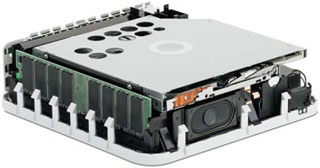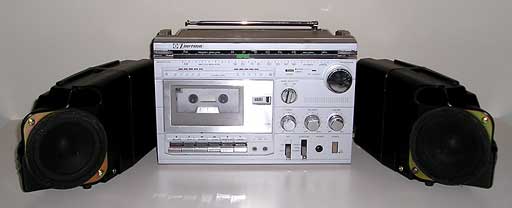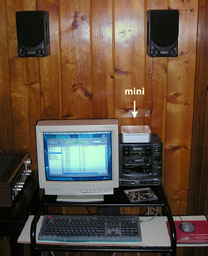Macintosh computers have been long considered more expensive
than comparable PCs, although many Mac users might consider
"comparable PCs" to be an oxymoron. That all changed with the
introduction of the Mac mini.
My first experience with the mini was at a local Apple Store
shortly after it became available. It was also my first experience
with OS X, so I spent 45 minutes getting to know the little Mac.
The Apple sales staff didn't bother me, so I was free to interact
with the mini and let it answer my questions.
There were two demo minis running in the store. They both had
the latest Apple keyboard and mouse and beautiful high-aspect-ratio
Apple Cinema Displays.
I knew then and there that there would undoubtedly be a Mac mini
in my future, but what about the peripherals? The 23" Cinema
Display was perfect for my needs but way beyond my means.
And the keyboard? Well, the layout was crowded, compared my old
Apple Extended and Design Keyboards.
My typing method is a combination of touch and hunt-and-peck, a
kind of touch-and-hunt style. My fingers are large and can be
clumsy when they move fast. (I'm also a horrible guitar
player.)
If you play a stringed instrument, you may know how it feels to
switch to another one that has slightly closer string spacing or a
different string length. At $29, the price of the Apple keyboard is
right, but for desktop use, its compressed design just doesn't
click for me.
Apple's new USB Mighty Mouse is expensive at $49 and not exactly
traditional in design - not that that's necessarily a bad thing. A
mouse needs to fit the user well, especially for graphics work and
gaming. If you can, find an Apple Store and try this mouse, but
also look at the 3-button Kensington PilotMouse Optical that they
sell for $19.95. Kensington also makes a 5-button "Pro" version of
this mouse targeted at graphics designers for about $5 more. For
another $10 beyond that, you can get the USB wireless version.
The Versatile Mac mini
Apple made the mini very attractive by allowing the buyer to use
almost any Mac or PC monitor and USB mouse and keyboard. This
allows for great creativity on the part of the user.
Last time, I walked you through the steps of getting a basic
mini for less than a quarter of its already-reasonable retail cost
(see Yes, You Can Get a 'Free' Mac mini - but
Is It Worth the Hassles?). Judging by the large volume of email
I got about the article, many LEM readers have decided to try their
luck with the promotion. I only wish I had come up with the
marketing strategy behind it.
This article discusses how the budget conscious Mac user can
turn their base-model Mac mini CPU into a very useable system for
very little cash. You can even have very good stereo sound for
virtually nothing, if you're willing to get down-and-dirty and
scrounge a little.
Some people might think that what I am proposing here is just a
tad too thrifty. Don't let anyone call you a cheapskate for
outfitting your new mini this way. Tell them you're not cheap, just
more resourceful than they are - then turn around and walk away
before they can think of a reply.
Keyboard and Mouse
If, like me, you aren't comfortable with Apple's peripherals,
new and used USB keyboards and mice are abundant and cheap on
eBay. I recommend that you get a keyboard that was
designed for Macintosh computers so that the keys are marked
correctly.
I was able to get a like-new Macally iKey keyboard (reviewed on LEM 1999.10.25) and an old round
Apple USB mouse (which LEM
labels a Road Apple) for less than $24 shipped. There have been
some problems reported with the Macally iKey, but this one works
perfectly with the mini. It also has identical layout and spacing
to the old ADB keyboards I'm used to and a slightly lighter
touch.
The Apple USB mouse got me up and running but was clearly not
designed for any human hand. I will be replacing it with an optical
mouse not too far down the road.
Monitor
Since a Mac mini isn't exactly a serious gaming box, the
monitor's best refresh rate shouldn't be a big consideration. Most
multiple-resolution monitors made in the past 10 years will work
fine for your mini's video, but newer is definitely better.
Your best bet is to look for an older PC monitor. Chances are it
won't have a DVI connector, but it will be a straightforward fit
with the VGA (standard older PC) adapter included with the
mini.
Macintosh monitors over 8 years old won't have a DVI connector
either but will require piggybacking a Mac-to-VGA to a VGA-to-DVI
adapter. It's anybody's guess what you might lose in the
translation. Mac-to-VGA adapters can be had for about $10 apiece on
eBay.
If you have been a Mac or PC user for any length of time, you
may have a spare CRT monitor or two. Since I am known in my
community as a free source of vintage Mac and PC support, old
donated monitors, Macs, PCs, and peripherals seem to walk in the
door and make themselves comfortable here. Occasionally some things
will leave, going free to a good home or to the dump, but mostly
they just pile up.
If you don't have a spare monitor and can't find a local
computer pack rat to give you one, try looking in your local
Goodwill, Salvation Army, or other thrift shops. You may have to
purchase a monitor with an old PC, but even so, the cost will
usually be worth it.
Make certain that the screen is even and bright when it's on and
that there are no images burned into it when it's off. You may have
to look at it from a few different angles to tell.
Also, look at the border around the image. It should be very
black when the brightness and contrast are set correctly. Look for
a row of 5 or more adjustment buttons. They may be behind a panel.
If you can't find a way to adjust the image size and shape from
outside the case, it might not be a multiple-resolution monitor. If
so, you should consider rejecting it.
If you have no luck at the thrift shops, try your local
"shopper" newspaper or the bargain corner of your local
newspaper.
If you can't find anything there, you may have to resort to eBay
for a good used monitor. Be tenacious about finding a seller within
driving distance. Unless it's a flat panel, you really don't want
to have a monitor shipped. Not only will it be very expensive but
chances are good that it won't be packed well enough to sustain the
rough handling it will get.
For my ultra-inexpensive mini system, I selected a 16.5" PC
monitor manufactured in 1997 from my monitor pile. Considering that
I'm used to a 20" monitor with an additional 16" display next to
it, this monitor may be restrictive for some of my needs. However,
it would work for most people, and it was absolutely free.
Working monitors like this one can show up at your local dump or
in city dumpsters. How down-and-dirty are you willing to get?
(Editor's note: One more suggestion is to drive around your
neighborhood very early on trash day. You may find a whole or
stripped computer, a monitor, or even furniture.)
Sound
Something that has been standard with every Mac from the original 128K on is at least one
speaker. Most internal Macintosh speakers are really just a stopgap
measure to provide basic sound support, with the exception of the
Quadra 900/950, which had pretty good mono sound.
If you wanted good stereo sound quality for your Mac, you
plugged in a pair of amplified speakers and bypassed the internal
one.
With the exception of the G4 Cube,
which shipped with external speakers, the diminutive mini continues
the unbroken tradition of including only an internal speaker. Like
some of the mini's other components, its tiny speaker was probably
recruited from laptop service. As such, it's really unsuitable for
most desktop audio requirements beyond playing system alerts.
 I do applaud Apple for finding room in the case for a
true voice-coil speaker and designing the case to actually enhance
the sound a bit.
I do applaud Apple for finding room in the case for a
true voice-coil speaker and designing the case to actually enhance
the sound a bit.
The Mac mini comes with a stereo-mini jack for headphones or
external amplified speakers.
I'm going to say this once because this reference can also be
found veiled in the manual: There is absolutely no need to
purchase a special audio system for your computer. You may
already have a good potential Mac or PC sound system lying around
your house somewhere.
Almost everybody has access to an old working stereo receiver
and speakers, boom box, or bookshelf stereo. It may be collecting
dust in a closet, attic, or basement. Check with your friends and
relatives. Go and get it. If it's working and it has left and right
auxiliary stereo RCA input jacks or one stereo-mini input jack
(like the headphone output on the mini), you're in business.
 If your
receiver has RCA inputs, you will also need an RCA to mini-pin
stereo adapter. You can make or buy these inexpensively at any
electronics store. You may also need a pair of stereo RCA hookup
cables if you don't already have them.
If your
receiver has RCA inputs, you will also need an RCA to mini-pin
stereo adapter. You can make or buy these inexpensively at any
electronics store. You may also need a pair of stereo RCA hookup
cables if you don't already have them.
If you receiver has a mini-pin input jack, you will only need a
stereo-mini-pin to stereo-mini-pin connector cable.
You are now ready to give your little Mac mini an authoritative
voice - or the sultry "Kathy" voice, if you prefer.
Speakers, Monitors, and Magnetic Fields
Keep in mind that your old stereo speakers weren't designed to
be used in close proximity to a computer monitor.
Speakers that are not designed for computer use are rarely
shielded. At some time, you may have seen a TV or monitor that had
an odd rainbow effect somewhere on or all over the screen. That
unit had been in the vicinity of a strong magnetic field, like one
created by a big loudspeaker magnet. Most modern CRT monitors have
built-in degaussing, but some (like the old 14" Macintosh Color
Display), were susceptible to this problem.
For safety, keep all non-shielded bookshelf-type speakers at
least two feet away from your monitor. Multi-driver systems
containing large subwoofers with massive magnets may need to be
kept even farther away. Have your monitor turned on and the system
booted and awake when positioning speakers. Watch for any
distortion of the screen and back the speaker off if you even think
you are seeing it.

I found the above vintage stereo radio/cassette receiver in my
house when I moved in. It has RCA inputs, but the speakers were
missing. The speakers pictured were liberated, enclosures and all,
from the family Toyota when it died. It's not pretty, but it makes
a fine computer sound system.
Hooking Up
Once you have your audio components positioned, plug your
mini-pin to RCA adapter with cables or dual mini-pin cable
(whichever is appropriate) into the Mac mini's headphone jack. Plug
the other end(s) into your receiver's auxiliary input jack(s).
Make sure the speakers are connected and the receiver is plugged
in, then go ahead and turn it on. You may have to set a switch on
your receiver to "Aux" or whatever other input you have your mini
connected to.
Now start your mini. The internal speaker will play the boot
tone, but all other sounds should come through your audio
system.
 My sound system for the mini,
consists of an old bookshelf CD player/cassette system. The CD
player quit working several years ago. It had no auxiliary inputs,
so I found the three (left, right, and common) leads that went from
the CD section and into the internal amp. I clipped them at the CD
board, soldered twin RCA jacks to the ends, and mounted the jacks
on the back of the case. The CD player's lid makes a good perch for
the mini and keeps the footprint on the desk to a minimum.
My sound system for the mini,
consists of an old bookshelf CD player/cassette system. The CD
player quit working several years ago. It had no auxiliary inputs,
so I found the three (left, right, and common) leads that went from
the CD section and into the internal amp. I clipped them at the CD
board, soldered twin RCA jacks to the ends, and mounted the jacks
on the back of the case. The CD player's lid makes a good perch for
the mini and keeps the footprint on the desk to a minimum.
The speakers are firmly attached to the wall behind and above my
computer desk. This not only gets them out of the way but precludes
them from being accidentally knocked over near the monitor.
This recycled audio system sounds better and is much more
adjustable than most commercial amplified computer speakers which,
by the way, don't come with working cassette decks and a radio.
The total cost of outfitting my Mac mini, including keyboard,
mouse, and audio adapters and cables was about $30. I will probably
spend another $25 on a good new optical mouse.
The fact that you can get away with this kind of scrounging is a
testament to the design of the Mac mini. Go ahead, feel free to
revel in your resourcefulness! 

 I do applaud Apple for finding room in the case for a
true voice-coil speaker and designing the case to actually enhance
the sound a bit.
I do applaud Apple for finding room in the case for a
true voice-coil speaker and designing the case to actually enhance
the sound a bit. If your
receiver has RCA inputs, you will also need an RCA to mini-pin
stereo adapter. You can make or buy these inexpensively at any
electronics store. You may also need a pair of stereo RCA hookup
cables if you don't already have them.
If your
receiver has RCA inputs, you will also need an RCA to mini-pin
stereo adapter. You can make or buy these inexpensively at any
electronics store. You may also need a pair of stereo RCA hookup
cables if you don't already have them.
 My sound system for the mini,
consists of an old bookshelf CD player/cassette system. The CD
player quit working several years ago. It had no auxiliary inputs,
so I found the three (left, right, and common) leads that went from
the CD section and into the internal amp. I clipped them at the CD
board, soldered twin RCA jacks to the ends, and mounted the jacks
on the back of the case. The CD player's lid makes a good perch for
the mini and keeps the footprint on the desk to a minimum.
My sound system for the mini,
consists of an old bookshelf CD player/cassette system. The CD
player quit working several years ago. It had no auxiliary inputs,
so I found the three (left, right, and common) leads that went from
the CD section and into the internal amp. I clipped them at the CD
board, soldered twin RCA jacks to the ends, and mounted the jacks
on the back of the case. The CD player's lid makes a good perch for
the mini and keeps the footprint on the desk to a minimum.
